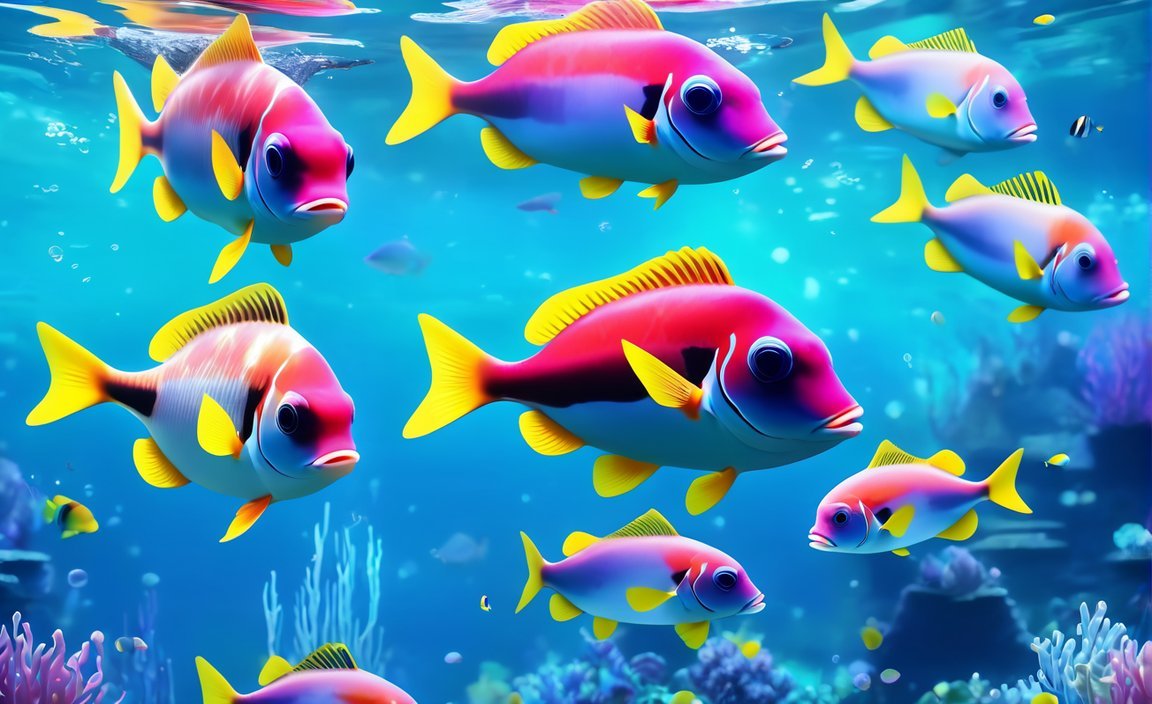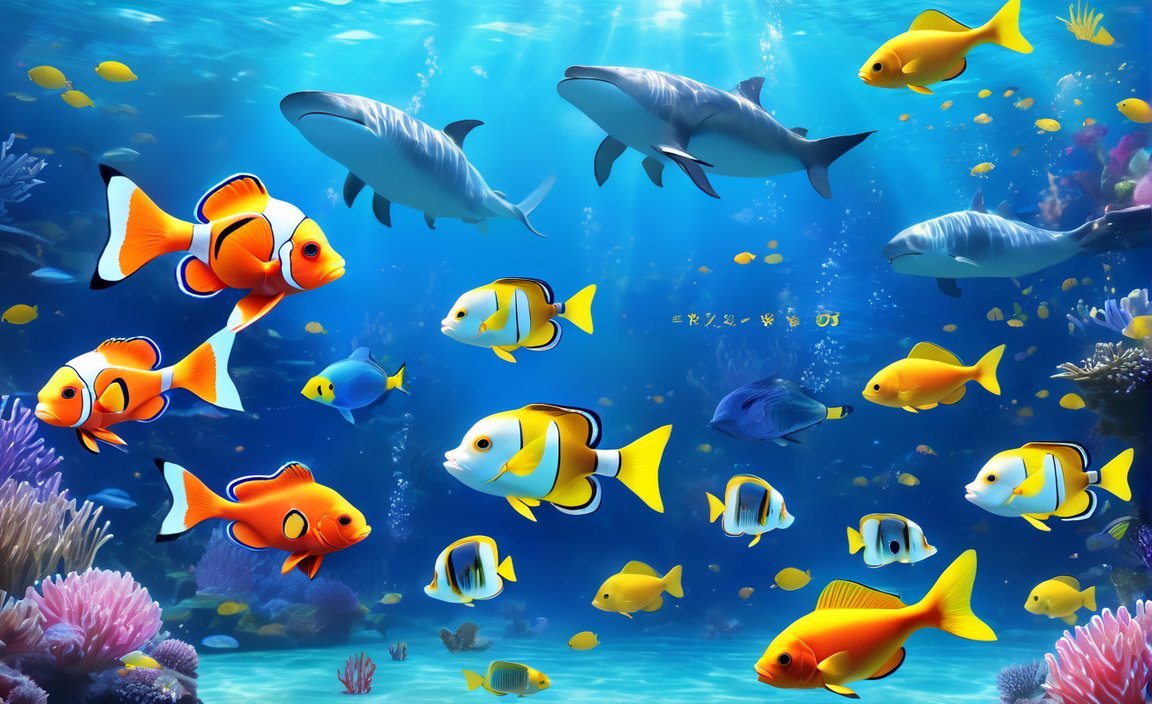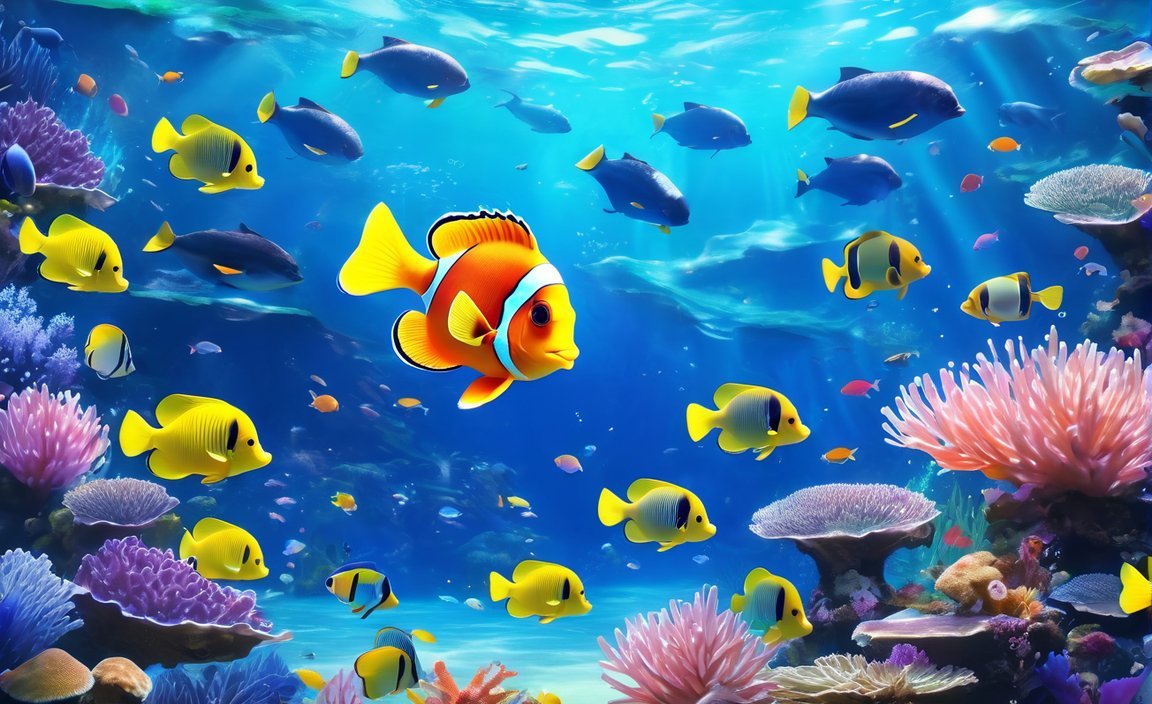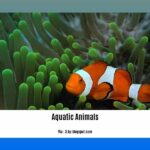Get ready to dive into the captivating world of aquatic animals as we uncover five fascinating facts that will leave you in awe. From the mysterious depths of the ocean to the vibrant reefs, these incredible creatures never cease to amaze. So, strap on your snorkel and get ready for a journey that will highlight the wondrous and lesser-known traits of these amazing underwater dwellers.

Key Takeaways:
- Seahorses are the only animals in which the males give birth and care for their young.
- Shrimp have their hearts located in their heads, highlighting the diversity and complexity of aquatic animals.
- Sea sponges lack many organs and body parts yet are alive, showcasing their adaptability and survival skills.
- Turtles have a wide global distribution, being found on every continent except Antarctica.
- Starfish can have up to 16 arms and possess the ability to regenerate limbs.
- Jellyfish are composed of 95% water, contributing to their translucent appearance and delicate nature.
- Orcas, or killer whales, are the largest members of the dolphin family and exhibit complex social behaviors.
- Fish have a natural defense mechanism in the form of gel-slime on their bodies that protect them from parasites.
- Octopuses have three hearts, allowing for efficient oxygenation and movement.
- Sea horses have a unique way of locomotion, using their chins to pull themselves around.
- Sharks possess robust immune systems and are immune to all known diseases.
5 Fun Facts About Aquatic Animals
Aquatic animals are a fascinating and diverse group of creatures that inhabit our oceans, rivers, and lakes. From seahorses to sharks, each species has its own unique characteristics and behaviors that make them truly captivating. In this article, we’ll explore five fun facts about aquatic animals that will leave you in awe of their remarkable abilities and adaptations.
1. Seahorses: The Ultimate Super-Dads
Did you know that seahorses are the only animals in which the males, not the females, give birth to and care for their young? It’s true! These charismatic creatures defy traditional gender roles and showcase some of the most unique reproductive strategies in the animal kingdom. The male seahorse carries fertilized eggs in a specialized pouch until they hatch, providing them with protection and nourishment. This incredible display of fatherly love sets seahorses apart from other animals and highlights the diversity of parental care in aquatic environments.
2. Shrimp: A Heart in Their Head
Here’s a fact that will make you look at shrimp in a whole new light: their hearts are located in their heads! This peculiar anatomy showcases the complexity and diversity of aquatic animals. While our hearts are nestled safely in our chests, shrimp demonstrate the incredible adaptability of these creatures and their ability to evolve unique physiological characteristics. So next time you feast on shrimp cocktail, remember that their hearts are beating right beneath their shells!
3. Sea Sponges: Miracles without Organs
Sea sponges are a truly remarkable group of animals because they lack many of the organs and body parts that other animals possess. They have no head, mouth, eyes, feelers, bones, heart, lungs, or brain, and yet they are alive. This fascinating fact showcases the incredible adaptability and survival skills of these creatures. Despite their simple body structure, sea sponges play crucial roles in marine ecosystems by filtering water and providing habitats for other organisms.
4. Turtles: Global Adventurers
Turtles are famous for their wide distribution across the globe. They can be found on every continent except Antarctica, showcasing their remarkable ability to thrive in various environments. These ancient reptiles have adapted to different climates and habitats, ranging from deserts to tropical rainforests and even the open ocean. With their sturdy shells and well-honed navigation abilities, turtles have conquered the land and sea, making them true world travelers.
5. Starfish: Nature’s Masters of Regeneration
Starfish, also known as sea stars, are truly incredible creatures. Not only can they have up to 16 arms, but they also possess the power of regeneration. If a starfish loses an arm, it has the remarkable ability to grow a new one, complete with all the necessary tissues, organs, and even eyes. This regenerative power showcases the adaptability and resilience of these unique animals. Imagine if we could regrow a limb like a starfish!
These fun facts only scratch the surface of the wonders that aquatic animals have in store for us. From the jellyfish’s high water content to the shark’s robust immune system, the world beneath the waves is full of fascinating discoveries waiting to be made. By learning more about these incredible creatures, we can deepen our understanding and appreciation for the diverse marine life that inhabits our planet.
Sources:
- All That’s Interesting – Amazing Facts About Ocean Animals
- Bank of Biology – Amazing Facts about Aquatic Animals
Here are some fascinating facts that will blow your mind about African bush elephants. Have you ever wondered why they are the largest land animals on Earth? Well, click here to discover 5 fun facts about African bush elephants.
Did you know that the ocean is home to some truly amazing creatures? Dive deep into the world of marine biology and unravel 5 mind-boggling facts. Click here to embark on an underwater adventure of knowledge.
Ever wondered how police dogs become such skilled and efficient members of the force? Discover the remarkable abilities and achievements of these incredible canines! Click here to unravel 5 intriguing facts about police dogs.
Raccoons may appear cute and cuddly, but there’s more to these masked critters than meets the eye. Prepare to be amazed as we uncover 5 fascinating facts about raccoons. Click here to join us on this wild journey of discovery.
Many aquatic animals communicate using fascinating methods.
Communication in aquatic animals is a captivating subject that sheds light on the intricate social interactions and evolutionary adaptations of these marvelous creatures. From the depths of the oceans to freshwater habitats, aquatic animals have developed diverse and fascinating methods of communication. In this article, we will explore some of the most intriguing ways in which aquatic animals communicate with one another.
Acoustic Communication: The Symphony of the Sea
Sound, as a signal modality, plays a significant role in the communication of many aquatic animals. Thanks to the unique properties of water, sound travels faster and over longer distances compared to air, making it an efficient means of communication underwater. Aquatic species have evolved various mechanisms to produce and detect sound.
- Fish: Fish species utilize their swim bladder or pectoral fin to produce a range of sounds, including boat-whistles, grunts, and croaks. These sounds serve purposes such as attracting mates and maintaining school structure.
- Frogs and toads: These amphibians use vibrating tissues in airflow to vocalize. Frogs, in particular, employ vocal sacs and an air-recycling system, while pipid frogs produce clicking noises through laryngeal muscle implosion.
- Aquatic mammals: Seals and otters produce sounds using their larynx. Acoustic signals are crucial for social recognition, mate attraction, and threat conveying in these marine mammals.
- Crustaceans: Even crustaceans such as fiddler and ghost crabs communicate by striking or tapping on a substrate, producing non-vocal noise.
Visual Communication: A Colorful Display
Visual signals also play a vital role in the communication of aquatic animals. From vibrant color changes to fin movements and courtship dances, visual displays contribute to various aspects of their lives.
- Social recognition and aggregation: Visual cues help aquatic animals recognize their own species and form social groups.
- Mating displays: Courtship displays involving vibrant colors and intricate movements are vital for attracting mates in many aquatic species.
- Agonistic behavior: Aquatic animals use visual displays to establish dominance hierarchies, defend territories, and signal aggression between individuals.
- Survival: Visual signals can serve as warnings to predators, indicating toxicity or dangerousness, allowing prey animals to avoid being eaten.
These visual displays are not only captivating but also provide insights into the complex social dynamics and survival strategies of aquatic animals.
Key Takeaways:
- Many aquatic animals communicate through acoustic signals, employing specialized organs and mechanisms for sound production and detection.
- Underwater, sound travels faster and over longer distances, making it a valuable mode of communication.
- Fish, frogs, aquatic mammals, and even crustaceans utilize acoustic signals for various purposes, including social aggregation, mate attraction, and threat communication.
- Visual communication plays a significant role in the lives of aquatic animals, facilitating social recognition, mating displays, agonistic behavior, and warning signals.
- Visual displays, such as vibrant colors and intricate movements, provide valuable insights into the social dynamics and survival strategies of aquatic animals.
Sources:
[1] Communication in Aquatic Animals – Wikipedia
[2] Acoustic communication in aquatic animals – Wikipedia
[3] Visual communication in aquatic animals – Wikipedia
Aquatic animals possess incredible camouflage skills for survival.
Camouflage is a vital survival tactic for many marine animals, allowing them to blend seamlessly into their surroundings and avoid detection by predators or sneak up on unsuspecting prey. Here are 8 fascinating marine animals that have mastered the art of camouflage:
1. Cuttlefish
- Habitat: Found in shallow coastal waters of the Mediterranean Sea and the Atlantic Ocean, inhabiting crevices in coral reefs.
- Camouflage capability: Cuttlefish possess specialized skin cells that can rapidly change color and texture to match their surroundings, allowing them to blend in perfectly[^1^].
2. Mimic Octopus
- Habitat: Native to the shallow waters of the Indo-Pacific region, typically found in sandy or muddy substrates, coral reefs, and seagrass beds.
- Camouflage capability: The mimic octopus has the incredible ability to mimic the appearance and motion of various other marine animals such as flounders, lionfish, and sea snakes, making it extremely difficult to spot[^1^].
3. Leafy Sea Dragon
- Habitat: Native to the southern and western coasts of Australia, living in shallow waters near seaweed beds.
- Camouflage capability: Leafy sea dragons possess intricate leaf-like appendages on their bodies that resemble floating seaweed, allowing them to blend in perfectly with their surroundings[^1^].
4. Frogfish
- Habitat: Found in tropical and subtropical oceans worldwide, mainly inhabiting shallow waters near coral reefs and rocky shores.
- Camouflage capability: Frogfish have special skin cells called dermal spinules that resemble algae or sponge, helping them camouflage effectively[^1^].
5. Stonefish
- Habitat: Primarily found in warm and shallow waters of the Indo-Pacific region, inhabiting shallow, sandy, or rocky areas near coral reefs.
- Camouflage capability: Stonefish can change the color of their skin to match their surroundings, making them almost invisible to both their prey and predators[^1^].
These marine animals showcase the incredible diversity of camouflage strategies in the underwater world. They have evolved specialized adaptations that allow them to blend seamlessly into their surroundings, ensuring their survival in their respective habitats.
Key Takeaways:
– Aquatic animals like cuttlefish, mimic octopus, leafy sea dragons, frogfish, and stonefish possess incredible camouflage skills for survival.
– Cuttlefish have specialized skin cells that rapidly change color and texture to match their surroundings.
– Mimic octopuses mimic the appearance and motion of other marine animals to evade detection.
– Leafy sea dragons have leaf-like appendages on their bodies that resemble floating seaweed.
– Frogfish have skin cells resembling algae or sponge for effective camouflage.
– Stonefish can change the color of their skin to match their surroundings, making them nearly invisible.
Sources:
1. Ocean Info: 8 Marine Animals that have Mastered the Art of Camouflage
2. ThoughtCo: Ocean Camouflage: How the Octopus and Other Creatures Blend In
Some aquatic animals exhibit complex and intelligent social behaviors.
When it comes to the underwater world, there is so much more than meets the eye. Dive into the depths with me as we explore five fascinating facts about aquatic animals, specifically focusing on the intriguing topic of complex and intelligent social behaviors.
Dolphins: The Masters of Social Interaction
Dolphins are well-known for their playful and friendly nature, but did you know that they also exhibit complex social behaviors? These intelligent creatures live in tight-knit pods and rely on strong social bonds for survival. They communicate using a variety of clicks, whistles, and body language, showcasing their ability to interact and cooperate with one another. Dolphins also demonstrate self-awareness and have been observed using tools, such as sponges, to protect their sensitive skin while foraging for food on the ocean floor.
Whales: The Chatterboxes of the Sea
Whales are not only the largest creatures on Earth but are also social animals with a remarkable ability to communicate. They produce a wide range of sounds, including songs that can travel for miles underwater. These vocalizations serve various purposes, such as attracting mates, establishing territories, and coordinating group activities. Some whale species, like humpbacks, even have unique songs that are passed down from generation to generation, showing their cultural complexity and intelligence.
Octopuses: Masters of Deception
Octopuses are celebrated for their incredible adaptability and problem-solving skills. These highly intelligent creatures are also capable of complex social behaviors. While they are typically solitary animals, they engage in intricate courtship rituals during mating season. Octopuses communicate through dynamic color changes and intricate body postures to signal their intentions and establish dominance. Some species have even been observed cooperating with one another in hunting expeditions, showcasing their complex social interactions.
Sea Otters: The Social Guardians of Kelp Forests
Sea otters are not only adorable but also exhibit intelligent social behaviors. These charismatic creatures form tight-knit communities known as rafts, where they engage in playful activities and social grooming. By holding hands while sleeping, sea otters create a strong bond within their groups, ensuring they do not drift apart. They also play a vital ecological role as they feed on sea urchins, helping to maintain healthy kelp forests and promote thriving underwater ecosystems.
Cuttlefish: Masters of Communication
Cuttlefish may seem like ordinary creatures, but they possess remarkable abilities when it comes to social communication. These cephalopods can rapidly change their skin color and display various patterns and textures, allowing them to blend into their surroundings or communicate with others. Cuttlefish use this sophisticated visual language during courtship displays, territorial disputes, and even to deceive their prey. Their complex social behaviors and communication skills highlight their intelligence and adaptability in the underwater world.
Key Takeaways:
- Dolphins exhibit complex social behaviors, including communication through clicks, whistles, and body language.
- Whales communicate using a variety of vocalizations, including unique songs passed down through generations.
- Octopuses engage in intricate courtship rituals and communicate through dynamic color changes and body postures.
- Sea otters form close-knit communities called rafts and engage in social grooming and playful activities.
- Cuttlefish possess remarkable communication abilities through rapid changes in skin color and texture.
Citation:
– American Oceans – source
– Ocean Fauna – source

FAQ
Q1: What makes seahorses unique compared to other animals?
A1: Seahorses are unique because they are the only animals in which the male, not the female, gives birth to and cares for their young.
Q2: Where is a shrimp’s heart located?
A2: A shrimp’s heart is located in its head, which showcases the diversity and complexity of aquatic animals.
Q3: How do sea sponges survive without organs and body parts?
A3: Sea sponges lack many organs and body parts, such as a head, mouth, eyes, feelers, bones, heart, lungs, or brain, yet they are alive. This showcases their incredible adaptability and survival skills.
Q4: Where can turtles be found?
A4: Turtles can be found on every continent except Antarctica, showcasing their ability to thrive in various environments.
Q5: How many arms can starfish have?
A5: Starfish can have up to 16 arms, making them unique and fascinating creatures. Their ability to regenerate limbs is also truly incredible.
















